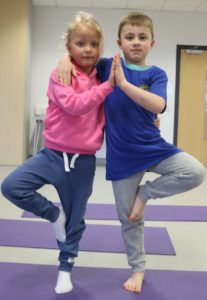Kalma Junior Children’s Yoga to help Dyslexia and Dyspraxia
Yoga can support children with Dyslexia and Dyspraxia by reducing anxiety, helping their coordination and balance, whilst also encouraging confidence with in the child. Our children’s yoga starts from 3 up to 12 years and will help equip children with tools to help positive self development. Classes are structured offering stretches, breathing and mindfulness. They support children to build resilience and confidence. Classes offer children many benefits to help Dyspraxia and Dyslexia.
What is dyslexia?
According to the British Dyslexia Association, ‘dyslexia is a learning difficulty that primarily affects the skills involved in accurate and fluent word reading and spelling’. It is characterised by difficulties in phonological (sound) awareness, verbal memory and verbal processing speed. Notably, dyslexia occurs across the whole range of intellectual abilities and is best thought of as a continuum, without any clear cut-off points. Co-occurring difficulties may also be seen in aspects of language, motor co-ordination, mental calculation, concentration and personal organisation.
What is Dyspraxia?
According to the Dyspraxia Foundation, ‘dyspraxia is a form of developmental coordination disorder affecting fine and/or gross motor coordination’. It may also affect speech and, again, occurs across the whole range of intellectual abilities.
Breathing such as alternative nostril breath, can help increase spatial memory according to a program ran by Manjunath and Telles. More tests concluded that it can help children’s perceptions in terms of dexterity, a core difficulty associated with dyspraxia in particular.

In yoga we pay attention to detail, we plan through sessions with breathing and asanas. Children prepare to stretch to move their body’s in particular ways. Each asana needs space giving children the awareness of this too. Mindfulness can help children deal with difficult life situations whether this be anxiety with emotions or life in school. Yoga has been known to increase concentration, poor attention can have a negative effect on dyslexia in terms of spelling and grammar.
Yoga appears to improve the efficiency of the cerebellum for children with dyslexia and dyspraxia (and also ADHD), with the right cerebellum having been found to be the best biomarker for dyslexia and related difficulties. Any asana practice which involves a focus of the visual field (e.g. balance-based asanas) is therefore likely to be particularly useful for these children, as are yogic eye exercises. The Dyspraxia foundation recommends some kind of relaxation which can be found inside of our children’s yoga classes. To find out more visit kalmalifeuk.co.uk.
